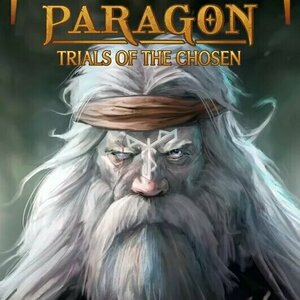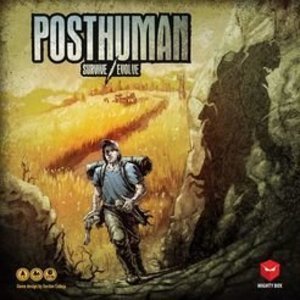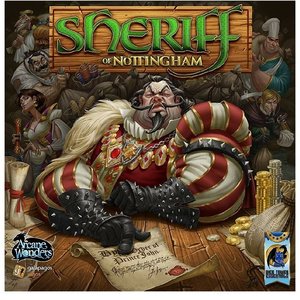
Paragon: Trials of the Chosen
Tabletop Game
Set in a fantasy world beset by warring demigods vying to join the eternal pantheon, Paragon: Trials...

Hades is Mine: Rise of Hades (Gods and Monsters #4)
Book
I am a Legend. Born to fight Death itself. Sworn to act as Zeus’ thunderbolt against the...
Merissa (13590 KP) rated Muted Chords (The Road to Rocktoberfest 2022) in Books
Nov 7, 2022
The pacing of this story is fast and felt a little rushed to me in places, but you will be drawn into the close-knit relationships between the band members. You also get a look at some people who are not so nice, who have let fame (or the lack of it) sour them.
Overall, this was a sweet love story between Josh and Bran and brilliant relationships between the rest of the band members. However, there is some derogatory language, plus some angst near the ending, so consider yourself warned.
** same worded review will appear elsewhere **
* A copy of this book was provided to me with no requirements for a review. I voluntarily read this book, and the comments here are my honest opinion. *
Merissa
Archaeolibrarian - I Dig Good Books!

Honestly Yours by Jaime Reese
Book
The truth hurts. But in the end, honesty wins. Or does it? Warren Prescott loves a challenge. He...
Contemporary MM Romance

The Cunning Cruise Ship Caper
Book
It’s been years since Sandy Fairfax was a teen idol and starred in his hit ‘70s television...

Stack the Countries®
Education and Games
App
- Featured on the TODAY show! - Editor's Choice Award! - Children's Technology Review - "Stack the...
Kirk Bage (1775 KP) rated Alita: Battle Angel (2019) in Movies
Jan 22, 2021
Alita: Battle Angel is a similar deal. This time Yukito Kishiro’s early 90s manga creation is the inspiration. With James Cameron as producer, and the considerable talents of Christoph Waltz, Jennifer Connelly and Mahershala Ali onboard, it would have been pretty hard for even Rodriguez to mess this up entirely. Although at times he does seem to try, mostly by doing too much and making certain sections too busy and too confusingly cross-genre, like he is frantically trying to colour within the lines whilst using every felt-tip in the pack. A habit that means every now and again something great happens, but you may have missed it in all the background noise.
Compare this film, that just falls short of qualifying for my Bad Movie Triple Bill list, to Spielberg’s superior yet similarly busy Ready Player One. Both involve high concept future realities that are very tech and AI driven. Both make extensive use of CGI and vivid colour palettes. Both are frenetic and demand an audience pays attention in order to fully appreciate the storyline. The difference is that one zig-zags back and forth in tone and momentum, and one is razor sharp in moving us from one idea to the next on a perfect learning curve towards a satisfying climax and conclusion. Guess which one is which? This is why Spielberg is Spielberg and Rodriguez is… a hack.
That said, Alita as a character and concept is charming, and you do therefore find yourself at least wanting to discover her story. The action scenes are also quite electric, and the visuals are often breath-taking. But the whole is less than the sum of the parts here, and we are left with something that can only really exist in the same box as dozens of admirable sci-fi B-movies aimed at teenagers, such as The Maze Runner, Mortal Engines and The City of Ember. It also continues to prove the point alongside Ghost in the Shell and Speed Racer that Anime / Manga into live action is a very tricky business.
There is definitely an audience out there for this movie, and I dare say at some point I will be tempted to give it another watch. What is definitely worth watching however, is how James Cameron uses this as a stepping stone to perfecting virtual humans on the big screen. I am sure everyone involved learned a lot in that respect, so all is far from lost.
Purple Phoenix Games (2266 KP) rated Crazier Eights: Camelot in Tabletop Games
Dec 23, 2020
War. Old Maid. Go Fish. Crazy Eights. These are classic card games we probably all grew up playing. There have been many re-themes and new difficulty layers spread upon them to make them even more interesting. While UNO certainly has cornered the market on the Crazy Eights base, we have a new contender: Crazier Eights. Recoculous has published several versions of this card game with different themes: Avalon, One Thousand & One Nights, Olympus, and Shahrzad. Today we are taking a preview of Crazier Eights: Camelot.
You HAVE played Crazy Eights right? The card game where you attempt to be the first to exhaust your hand of cards, but you can only play down if you can match the suit or number on top of the discard pile? And if you can’t, you throw down an 8 as a wild and call the color to be played next? Well there you have the easy rules. Crazier Eights: Camelot (which I will from here call C8C) holds basically the same rule-set with a few new mechanics and a theme. The win condition is still the same: be the first to exhaust your hand of cards, but to win you will need to play your hand strategically against your opponents.
DISCLAIMER: We were provided a copy of this game for the purposes of this review. This is a retail copy of the game, so what you see in these photos is exactly what would be received in your box. I do not intend to cover every single rule included in the rulebook, but will describe the overall game flow and major rule set so that our readers may get a sense of how the game plays. For more in depth rules, you may purchase a copy online or from your FLGS. -T
To setup, shuffle the large deck of cards and place the deck in the middle of the table. Flip the top card to begin the discard pile and dictate the first card play. Deal each player seven cards and you are ready to begin!
The turn structure is familiar: check for any “start of turn” effects and apply them, draw a card, play and/or discard a card, then resolve any “end of turn” effects. The deck is comprised of Events and Assets in different colors (suits) and numbers like in a typical deck of playing cards. After checking and resolving start of turn effects on Asset cards in your personal tableau, you must draw a card from the deck. This is where C8C strays from OG Crazy Eights a bit. You may play a card from your hand (Assets and Events) and discard a card to the discard pile (matching the suit/number/or an Eight), or simply play a card from your hand without discarding. Cards played from your hand can be Event cards that are played, resolved, and then discarded to the bottom of the discard pile, or an Asset card that is played to your tableau that cause chain reactions or other abilities on future turns. Next, resolve any end of turn effects from Assets in your tableau before the next player begins their turn.
Play continues in this fashion until one player has rid themselves of their hand and is crowned the Master of the Camelot! Or at least, the winner of the game.
Components. This game is a box full of cards. The cards are good. The layout makes sense, and the art on the faces of the cards remind me of very classic art depicting ancient Arthurian scenes. I am no art historian, so I do not know if they are existing art pieces or new ones crafted for this game, but either way, they are a joy to behold… if you can spend the time appreciating the art instead of tracking what cards you need to play and what effects you can chain together (that was me). Extra points to the Recoculous team for associating symbols with the different suit colors for our colorblind friends. This is something that unfortunately goes unaddressed far too often.
This implementation is the third Crazier Eights we have had the chance to try, and I can say that we really enjoyed our plays of it (we played Olympus first and recently also reviewed Pantheon). The game comes with many interesting and varied effects to craft an ingenious strategy, and the art is stellar. Beware of playing with AP-prone gamers, as there is a lot going on and it is more than just a skinned Crazy Eights.
This Camelot set is slightly different than our previous experiences with both Olympus and Pantheon in a few ways. Firstly, it is more of a base game deck like Olympus instead of a standalone/expansion like Pantheon. Secondly, this set seems to use more cards that affect the assets of other players, specifically in destroying them. Additionally, I have noticed a few cards in the deck that specifically say if certain criteria are met one player automatically wins or loses the game. That’s it. Done-zo. Maybe I missed these cards in the other sets, but I do not remember them ever surfacing. Having each set focus on different aspects of the game and the manipulation of the rules ever so slightly to affect a player’s strategy from one set to the next is quite enchanting to me. Could you put all the sets together to make a massive meta-deck a la Munchkin with all the sets and expansions? Probably, but like Munchkin, I probably would rather keep them separate.
Now having played this family of games several times, I can say that it is my favorite Crazy Eights derivative and certainly worthy of a look. If your game collection is sorely lacking in Arthurian-themed card games, or if you want a hybrid game of old school rules with interesting twists, then do consider purchasing this or one of its predecessors.
PS – Don’t worry if, while you are playing, you have all your Assets stolen or destroyed. I have won the game with zero Assets in front of me while opponents have had eight, ironically. Assets are great, but you still need to shed your hand.
Purple Phoenix Games (2266 KP) rated Sheriff of Nottingham in Tabletop Games
Nov 16, 2021
Disclaimer: I have the first edition of this game, so the pictures below do not reflect the art/component changes brought in the recently released second edition. -L
Sheriff of Nottingham is a party game of bluffing, negotiation, and set collection in which players are trying to earn the most money by bringing their goods (Legal or Contraband!) to market. However, before those goods can get to your merchant stand, they must be cleared to pass by the Sheriff of Nottingham. Are you honest in your declarations, or are you trying to sneak something past the town authority? Bluff, bribe, or negotiate your way to victory and collect the most gold!
To setup for a game of Sheriff of Nottingham, each player receives a merchant stand board and bag in their chosen color, 20 starting gold, and 6 Goods cards. The remaining Goods cards are placed in a draw pile, with 2 adjacent discard piles. Turn over 5 cards to each discard pile, select a starting Sheriff, and the game is ready to begin! Sheriff of Nottingham is played over a series of rounds, and each round is broken down into 5 phases: Market, Load Merchant Bag, Declaration, Inspection, and End of Round. Important note – the player acting as Sheriff for the round will only act in the Inspection phase of a round. During the Market phase, players have the opportunity to discard unwanted Goods from their hand in order to draw cards from the draw pile or either discard pile. New cards are drawn one at a time, and you will draw as many cards as you have chosen to discard. The cards you discard will be placed in either discard pile, in whatever order you choose.
The next phase, Load Merchant Bag, is pretty self-explanatory. All merchant players will select up to 5 cards from their hand to place in their merchant bag. Snap it closed, and place it in front of you for the next phase, Declaration. In this phase, players will take turns declaring what good they are bringing to market. You must say exactly how many cards you are bringing, and you may only declare 1 type of Legal good! Even if your bag has multiple types of goods, you must declare only 1 type. Here is where your bluffing skills come into play! Once all players have made their declarations, the game moves to the Inspection phase, and it is now time for the Sheriff to act! In this phase, the Sheriff will get to decide if they wish to inspect any of the merchant bags, and merchants will have the opportunity to negotiate or bribe the Sheriff to not inspect their bag, or to inspect an opponent’s bag instead. If you make a deal with the Sheriff, you must hold up your end of the agreement!
Once the Sheriff has made their decision, they will either inspect bags or allow them to pass. If you are allowed to pass, you will take back your bag, open it, and add all goods to your merchant stand in their corresponding locations. Legal goods are known to all players, but Contraband goods are kept face-down. If the Sheriff chose to inspect your bag, they will open it and reveal the cards inside. If you were in fact telling the truth, and the cards inside are exactly what you declared, you add them to your merchant stand and the Sheriff will pay you a penalty for each Good card in your bag. If you were lying, a few things happen. First, any goods that were truthfully declared will go to your merchant stand as normal. Any goods that you lied about are confiscated by the Sheriff, and placed onto either discard pile. You then will pay the Sheriff a penalty fee for each confiscated good! The final phase, End of Round, has all players draw back up to 6 cards in hand, and the Sheriff title passes to the next player. The game continues in this fashion until all players have been the Sheriff twice (or three times in a 3-player game). Points are counted up – from your goods in your merchant stand, any gold coins you possess, and any bonus points for majority of Legal goods compared to opponents. Once all points have been tallied, the player with the highest score wins!
I know that I have said before that I generally don’t like bluffing games, but I think that Sheriff of Nottingham might be an exception. Yes, in some cases you will have to bluff about the contents of your merchant bag, but the ability to bribe/negotiate with the Sheriff takes some focus off the actual bluffing part. Can you convince the Sheriff to inspect another player’s bag just because you are trying to hinder that player? Or do you try to get the Sheriff to inspect your own bag, because then they will have to pay you a penalty fee for your honesty (this round, at least). It feels like there is more strategic gameplay here than simple bluffing, and I like the opportunity to strategize instead of relying solely on my (admittedly horrendous) poker-face.
Another thing that I really like about Sheriff of Nottingham is that it can technically be categorized as a party game, but it doesn’t feel like a typical party game to me. It takes strategy to play, and doesn’t just rely on crude/adult humor for laughs. This game really engages all players at all times, as you’re constantly watching your opponents, keeping track of what goods they seem to be collecting, and trying to catch them in a lie. The gameplay itself is pretty streamlined and straightforward, and that just helps to make it flow naturally and logically. The playing time is listed as 60 minutes, but it doesn’t feel like a long game to me at all. It’s just a light, fun, and entertaining game for really any type of game night.
Let’s talk components for a minute. Again, I have the first edition of the game, so I cannot speak as to any component changes in the second edition. But overall, the quality of the first edition is pretty nice! The merchant stand boards are nice, thick cardboard, and are colorful and clear. Perhaps my favorite part of the boards is they each have a turn order reference on them. Not that the gameplay is that complicated, but it’s nice to just have that quick guide. The Goods cards are good quality and feel nice in hand. The artwork is mostly pretty simple, but I like that, since the crux of the gameplay is in the player interactions. The cardboard coins are chunky, and the insert doubles as a draw/discard pile organizer – which to me is a lifesaver! Nothing bothers me more than unruly stacks of cards. The merchant bags are nice and mostly functional. My biggest issue with them is that sometimes the snaps are a little hard to open, and it feels like you might tear the bag if you pull on them too hard. To alleviate that, I just don’t have players actually close the snap, instead just folding over the flap, and that works just as well! Great production quality in my opinion.
So if I seem to like this game, why did I only give it a 4 out of 6? The simple answer to that is that I do like the game, but I don’t love it. It’s fun and serves its purpose well, but it’s not a game that I am dying to pull out every game night. It’s one that will stay in my collection for sure, because there are some occasions that are just perfect for it. But it’s not one that will ever make its way to my Top 10. All in all, it holds up well for being an ‘older’ game, but it doesn’t exactly have me jumping up and down to play. That’s why Purple Phoenix Games gives this one an 11 / 18.




